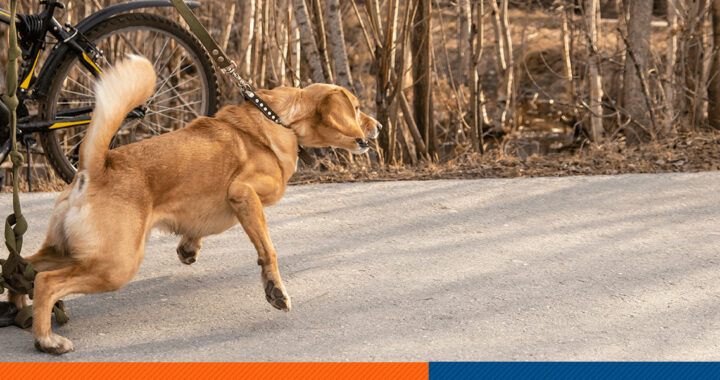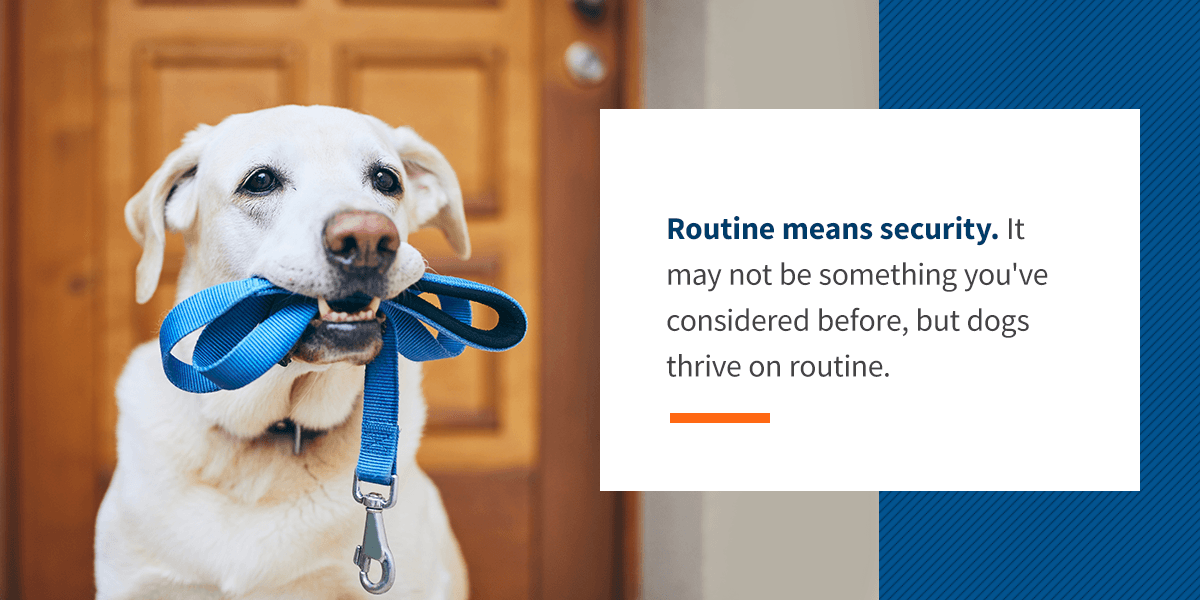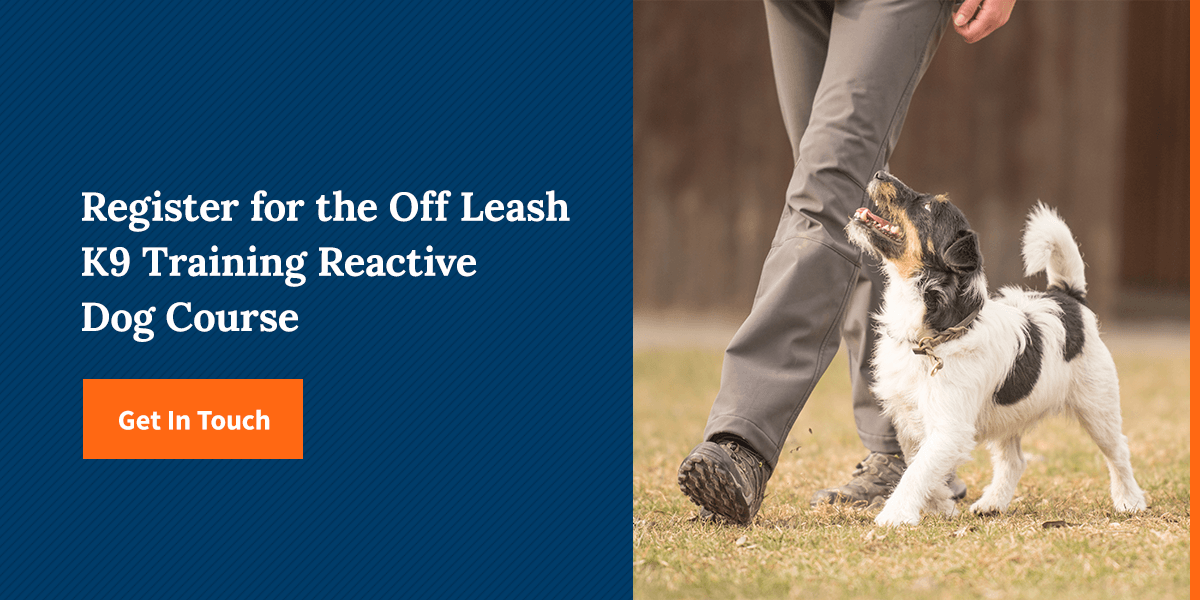Table of Contents
- Setting Your Reactive Dog Up for Success
- Creating and Sticking to a Schedule
- Desensitizing a Reactive Dog
- Reactivity Training Tips
- Register for the Off Leash K9 Training Reactive Dog Course
A reactive dog means they find stimuli in their immediate environment challenging to handle, which causes them to overreact. Reactive dogs are not necessarily aggressive, although they do an excellent job of looking like it. Overreactions to stimuli include barking, growling, lunging and posturing.
The reason why your dog is reactive could be due to several factors, including genetics, socialization and triggering episodes in their early development. Handling reactive behavior can be challenging, especially while your dog is on its leash. Overstimulation also affects a dog’s quality of life. Responding to reactivity with calm behavior is the first step to calming your reactive dog.
Setting Your Reactive Dog up for Success
A reactive dog responds to triggers in their environment. For whatever reason, they see these triggers as a threat. Calming your reactive dog requires training, desensitization, a good understanding of their body language and clear boundaries. Before you start training, set your dog up for success using the following tips and tricks:
- Avoid triggers: When your dog is triggered, instinct takes over and they go into fight or flight mode. For your dog to pay attention to you and learn, they need to be calm.
- Manage your dog and the environment: Training a reactive dog requires awareness of your environment to avoid triggers. When you take your dog out in public, ensure you always have a backup plan — another route you can take, a quiet street or a quick exit.
- Put yourself in your dog’s paws: Your dog isn’t being naughty — they are reacting to a perceived threat. You must provide them with positive experiences from a safe distance to change thought patterns.
- Remove triggers: Often, the most effective way to stop unwanted behavior is to remove the trigger. Removing a trigger not always be possible, but you can control what your dog sees. Block unwanted visuals and move your dog to a place in your home with limited access to triggers.
- Study canine body language: Dogs communicate with their bodies, and there’s plenty of research available on canine body language. Read up, watch videos and compare your dog’s behavior in different situations. In time, you’ll be able to predict a reactive outburst.
- Make some changes: Identifying triggers might give you the information you need to change your routine.
- Focus on safety: Reactive behavior is often a result of your dog feeling threatened. Think about how you can make your dog feel safer and boost their confidence in different situations.
- Plan: When unsure how your dog will react to a new stimulus, avoid it in the early stages. If there’s no need to expose your dog, it might be best to avoid it altogether.
Creating and Sticking to a Schedule
Routine means security. It may not be something you’ve considered before, but dogs thrive on routine. When you think about it, it makes sense — a schedule makes the world more predictable and less frightening. Sticking to a routine schedule is key to helping a reactive dog.
Our canine friends are already more aware of our routines than we realize. An anxious dog might be happier with a straightforward and constructive schedule. Start your routine at home where your dog is comfortable, and try to do the same things at the same time every day.
Once you’ve solidified your home routine, you can start adding to it by going for walks and car trips. Remember, these outings must be part of your schedule so your dog knows when to expect them.
Desensitizing a Reactive Dog
Desensitizing your dog involves pairing a trigger with something positive. Start small and from a safe distance before gradually incorporating the trigger into your dog’s immediate environment. Make a list of your dog’s triggers, from the most acute downward. When these triggers appear, be ready with a high-value treat. If your dog doesn’t take the food, they are over the threshold and needs to be further away from the trigger. Consider the following stages of reactivity. You can think of them in terms of color — the red zone, orange zone, yellow zone and green zone:
- Highly reactive (The red zone): Your dog is barking and lunging and can’t respond to verbal cues. They won’t take treats and may bite if feeling threatened.
- Moderately reactive (The orange zone): Your dog will be tense and strain against the leash. They’ll have a stiff, alert posture and may growl or give low, huffing barks as a warning. They may not accept treats.
- Somewhat reactive (The yellow zone): Your dog is alert, stares at the trigger and may require several cues to focus on you.
- Calm and focused (The green zone): The green zone is where you want your dog to be during desensitizing training. They’ll be happy to sniff the ground and take treats, so they can focus on you and follow your commands on a relaxed leash.
When desensitizing your dog, watch their behavior closely. If they move into more reactive zones, increase the distance between them and the trigger until they are comfortable. Reward your dog when they focus on you and follow your commands.
Reactivity Training Tips
Training your dog requires a combination of desensitization and management. Management means taking control of your dog’s environment and making it as trigger-free as possible. Ideally, training will result in a dog that can self-soothe and handle external situations without too much human interference. Consider the following tips to make your training more successful:
- Watch your body language: As you approach a potential trigger, you may feel compelled to shorten the leash and tense your body. Your dog picks up on your body language changes and becomes more fearful. Stay calm.
- Know your dog: Knowing your dog well gives you time to react and respond before they reach the highly reactive zone.
- Give your dog plenty of exercise: Exercise burns off excess energy and makes your dog calmer, more responsive and more comfortable.
- Provide mental stimulation: Keeping your dog’s mind busy is just as important as exercise. If your dog has something else to focus on, they will feel less threatened by external triggers.
- Train your dog to focus: Start your training at home. Bring a high-value treat up to eye level and instruct your dog to “watch.” Reward your dog when they make eye contact.
- Be patient and consistent: Training takes time. Your dog may not always understand what you’re saying, but getting frustrated will make them more anxious. Your dog will understand what you’re asking more quickly if you train consistently.
- Stay away from punishment: Verbal and physical aggression will heighten your dog’s fight or flight response and make it difficult to respond to your commands.
- Give your dog plenty of praise: Praise your dog enthusiastically when they perform the behavior you’re looking for, so they know the difference between right and wrong.
- Consult a professional: Professional help from experienced experts is more likely to have a successful outcome. Do your research if you’d like to bring in an expert, and make sure you choose a reputable trainer.
Register for the Off Leash K9 Training Reactive Dog Course
With Off Leash K9 Training Maryland, you can have a well-behaved dog that’s good at solving problems. If you’re struggling with a reactive dog anywhere in Maryland, we provide an individualized approach to training to work on triggers one step at a time. Our knowledgeable and compassionate trainers will assess your dog’s personality and training needs to provide personalized instruction for each unique pet, regardless of age or breed. To speak with one of our experienced trainers, call us at 443-743-3221.
No unwanted behavior is too much of a challenge for us. Please get in touch with us today, and let us help you learn how to train your reactive dog!



